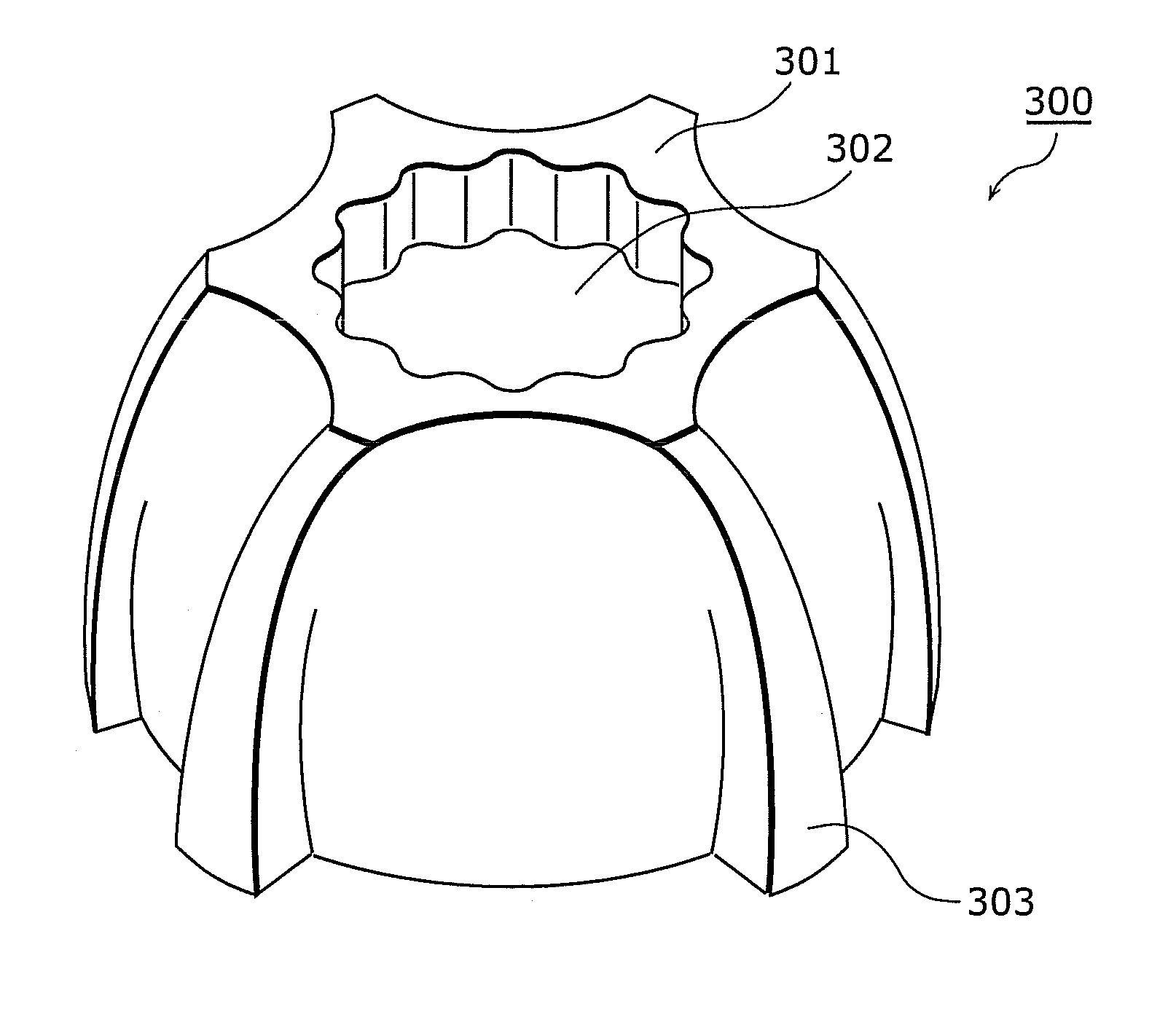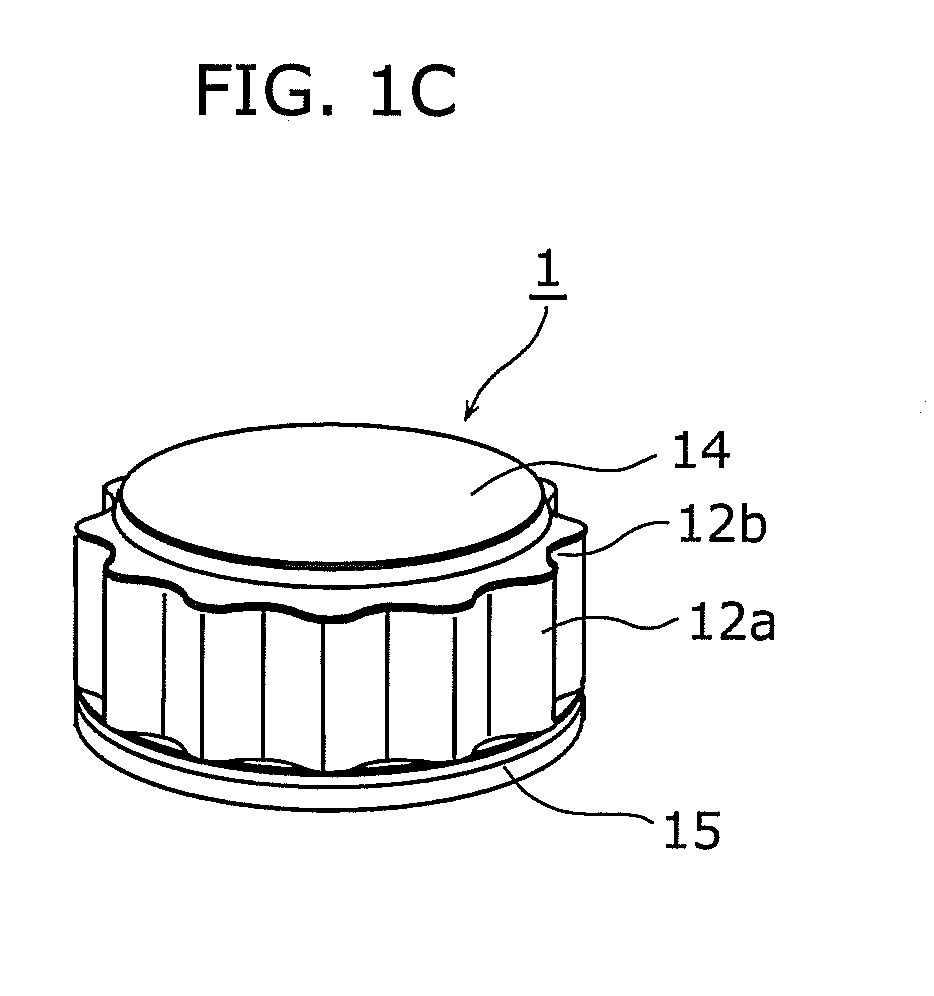Plastic bottle closure, plastic bottle including the same, and plastic bottle closure opener
a technology of plastic bottle and opening, which is applied in the field of plastic bottle closure, can solve the problems of increasing the amount of resin required for forming the closure, the closure would not give sufficient frictional force to weak grip users, and the manufacturing cost is significant, so as to achieve the effect of increasing the amount of resin required, increasing the manufacturing cost, and sufficient frictional for
- Summary
- Abstract
- Description
- Claims
- Application Information
AI Technical Summary
Benefits of technology
Problems solved by technology
Method used
Image
Examples
first embodiment
[0089]First, a closure 1 according to a first embodiment of the present invention will be described in detail with reference to the drawings. FIG. 1A is a plan view of the closure 1 according to the first embodiment of the present invention, and FIG. 1B is a partially cutaway cross-sectional side view of the closure shown in FIG. 1A. A cross-sectional portion in FIG. 1B shows a cross section of the closure when cut away along line A-A′ shown in FIG. 1A. In addition, FIG. 1C is an external perspective view of the closure shown in FIGS. 1A and 1B.
[0090]As shown in FIGS. 1A to 1C, the closure 1 according to the first embodiment of the present invention includes a closure base portion 11 and a concavo-convex portion 12.
[0091]The closure base portion 11 has a capped cylindrical shape, and, for example, is the same as an existing closure included in a plastic bottle available on the market. Accordingly, in an inner circumferential portion of the closure base portion 11, a screw portion 13...
second embodiment
[0124]Next, the following will describe a closure 2 according to a second embodiment of the present invention. FIG. 7A is a plan view of the closure 2 according to the second embodiment of the present invention, and FIG. 7B is a partially cutaway cross-sectional side view of the closure 2 shown in FIG. 7A. A cross-sectional portion in FIG. 7B shows a cross section of the closure when cut away along line B-B′ shown in FIG. 7A. FIG. 7C is an external perspective view of the closure shown in FIGS. 7A and 7B.
[0125]The closure 2 according to a second embodiment of the present invention is characterized in that the concavo-convex portion 22 formed using a dodecagonal socket wrench hole is formed only in a portion in a height direction of the closure.
[0126]The closure 2 according to the second embodiment of the present invention as shown in FIGS. 7A to 7C includes a concavo-convex portion only in an upper part of the lateral circumferential portion of the closure 2.
[0127]Note that the same...
third embodiment
[0133]Next, the following will describe a closure 3 according to a third embodiment of the present invention. FIG. 8A is a plan view of the closure 3 according to the third embodiment of the present invention, and FIG. 8B is a partially cutaway cross-sectional side view of the closure 3 shown in FIG. 8A. A cross-sectional portion in FIG. 8B shows a cross section of the closure when cut away along line C-C′ shown in FIG. 8A. FIG. 8C is an external perspective view of the closure shown in FIGS. 8A and 8B.
[0134]The closure 3 according to the third embodiment as shown in FIGS. 8A to 8C includes a concavo-convex portion only in a lower part of the lateral circumferential portion of the closure 3.
[0135]Note that the same configurations in FIGS. 8A to 8C as those of the closure 1 according to the first embodiment of the present invention are assigned with the same numerical references, and the descriptions thereof will be omitted.
[0136]As shown in FIGS. 8A to 8C, the closure 3 according to...
PUM
| Property | Measurement | Unit |
|---|---|---|
| diameter | aaaaa | aaaaa |
| size | aaaaa | aaaaa |
| thickness | aaaaa | aaaaa |
Abstract
Description
Claims
Application Information
 Login to View More
Login to View More - R&D
- Intellectual Property
- Life Sciences
- Materials
- Tech Scout
- Unparalleled Data Quality
- Higher Quality Content
- 60% Fewer Hallucinations
Browse by: Latest US Patents, China's latest patents, Technical Efficacy Thesaurus, Application Domain, Technology Topic, Popular Technical Reports.
© 2025 PatSnap. All rights reserved.Legal|Privacy policy|Modern Slavery Act Transparency Statement|Sitemap|About US| Contact US: help@patsnap.com



